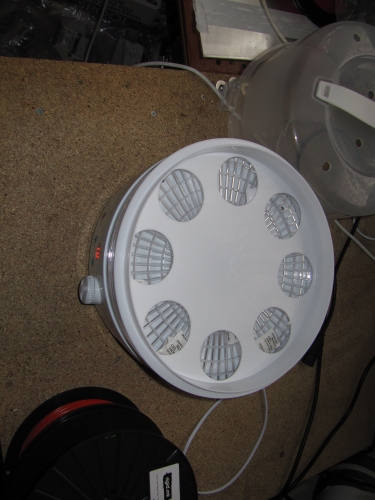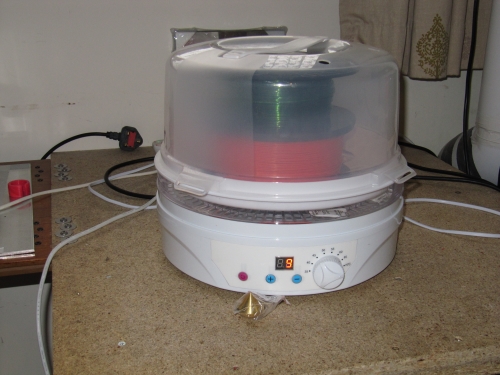PETG Drying
-
@doctrucker said in PETG Drying:
Looks like I will need to cut out some trays
or print an extension. I just mocked up some 30 degrees sections and snapped together and on a tray with enough height to hold my widest spool
-
Wes,
Susi from "Rigid Ink" once sent me details of how to make a home brew filament dryer which she claimed worked really well. It's still on my "todo" list of things to make so I haven't got around to it but I'll see if I can dig out her email and forward it to you.
-
@deckingman I would be interested in that as well ...
-
@deckingman Me also please.
-
Some companies are now making real-time filament drying:
- Fyladry (interview here: https://youtu.be/-FvGRm7I1Dc?t=307)
- Thordsen 3D (interview here: https://youtu.be/0cj6dqMgja4?t=1032)
-
Ok, here is what Susi from Rigid Ink sent me
But I haven't tried it so don't blame me .......
You need of of these https://www.amazon.co.uk/Digital-Food-Dryer-Dehydrator-temperature/dp/B008MPBK8G
and one of these https://www.amazon.co.uk/Whitefurze-Round-Cake-Plastic-White/dp/B00YJ83MHW
These are the pictures she sent


And this is what she said, quote:
"As you can see, I just put the silica gel sachets on the grill of the bottom segment, then the reels in the top part.
Hope this helps you out - I find it an essential addition for when printing with nylon-based materials and PVA.
Just don't go over the Glass Temperature of the filaments being dried. The exception is nylon (Tg is ~41°C) as it has a very high heat deflection point (compared to the Tg) - I usually dry that around 55-60°C."
End of quote............
-
This one looks like mine, but instead of buying the cake box, I just cut the middle of trays. It works.
But I like the idea of drying the silica gel at the same time. -
Thanks for the links. Will try at some point and report. Humidity sensor hooked up to Arduino may be investigated!
-
@doctrucker said in PETG Drying:
Thanks for the links. Will try at some point and report. Humidity sensor hooked up to Arduino may be investigated!
you can interface a humidity sensor to the Duet as well:
https://duet3d.dozuki.com/Wiki/Gcode#Section_M305_Set_temperature_sensor_parametersChannels 400, 401... are DHTxx temperature channels. The DATA line of the DHTxx must be connected to one of pins CS1, CS2... on the SPI bus. Specify the sensor type (11 for DHT11, 21 for DHT21 or 22 for DHT22) via the T-parameter. e.g. M305 P102 X401 T22 S"DHT temperature"
Channels 450, 451... are as 400, 401... but specify the corresponding humidity sensor of the DHTxx
So in theory you could have heaters/fans connected to a filament chamber that was controlled by the Duet and also fed the printer.
-
@t3p3tony sounds good, the mirror of a hopper pre-heat/dryer on a molding machine. Neat, and could keep the filament dust free too. I'll bare that in mind and ensure anything I buy for it can be ported across.
-
@fma said in PETG Drying:
Some companies are now making real-time filament drying:
- Fyladry (interview here: https://youtu.be/-FvGRm7I1Dc?t=307)
- Thordsen 3D (interview here: https://youtu.be/0cj6dqMgja4?t=1032)
Filadry its a scam, Fake specs and low quality product. Its like an anet dryer.
-
I'm not surprised. This is something I would not buy until I see good reviews with decent testing setup.
-
I'm the one who got @deckingman's wet PETG, I've actually used it all up now (thanks again!), and used it to drive development of my vacuum filament dryer.
Here's the writeup -
That's a very nice write-up for your vacuum dryer. I may investigate it myself. I currently use a large food dehydrator for the filament, and a small convection oven for silica gel, but they each just dump the humidity back into the room. I already have a nice vacuum pump, so I'd save on that.
-
-
Well, I have just ordered from Amazon what Deckingman posted above from Susi.
Need to try something just incase, as Phaedrux and Deckingman have suggessted it might be damp..
I printed 6 PET-G parts last night and they all were weak and the slightest presure they snapped, like a twiglet.
The PET-G was stored in an air tight bucket with silica.


I am printing a pair in the PETG-G CF which I struggled with in another post, after it had been in the airing cupboard for over 24hours, and made sure my partner did not put her washing in there!
I found 2 of the original brackets I printed in PET-G 2 weeks ago, same manufacturer as of the snapped ones, applied the same sort of pressure as I had with the ones above and increased it and they did not snap, much much stronger.

-
It really sounds like over cooling with the weakness between layers. Then It occured to me that the Ender 3 hotend fan blows quite a bit downward onto the parts through the gap around the heat block. Perhaps you could seal up the gap somehow.
I haven't printed PETG on my Ender 3 yet, but it seems like others do so without too much trouble. Is your ambient temp rather low? Perhaps a makeshift enclosure could help.
-
I am not running a part cooling fan, its about 18/19 deg C in my upstairs workshop.
This is my hotend.

Titan Aero's fan blow towards the heatsink, according to E3D that is correct.
This the outlet from the heatsink, all 4 edges.

I coud turn the fan around so it pulls the air through the heatsink.
The light blue parts were printed with the same hotend.I had a delivery today, I shall craft an enclosure!
-
Ah yes, you're using the Titan Aero, I forgot. I was thinking of the stock Ender.
Still, the Aero does blow downwards a bit. Especially with the stock fan. That thing is quite powerful.
Maybe give something like this a try?
https://www.thingiverse.com/thing:2325332
I used it myself before swapping the stock Aero fan for a Noctua.
-
@phaedrux Your a star, I shall print them tomorrow.
Wish I coulld buy you a beer or drop a bottle of your fave tipple round!
P.